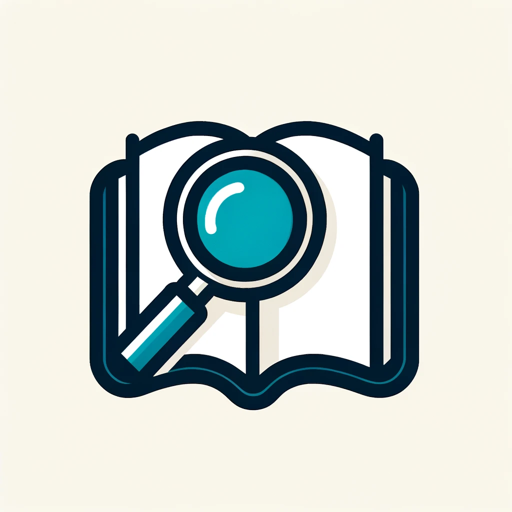Project PathFinder-AI-powered project assistance
AI-driven project management made simple
How do I create a project timeline?
What are some risk management strategies?
How can I improve team collaboration in my project?
Suggest some project management tools.
Related Tools
Load More
Framework Finder
Helps locate and apply frameworks to your problem

Pathfinder Mastermind
Pathfinder 1e guide with a wizardly storytelling flair

Codebase Navigator
Your Langchain codebase assistant.

UiPath PathFinder
Helping you clear a path to answers for any UiPath or Intelligent Automation related questions! Please leave a review and let us know if PathFinder helped or share ideas on improvement!

[HackGPT]: ROOT
Explore the backend of chatgpt.

Forager
Precision online searches with expanded capabilities.
20.0 / 5 (200 votes)
Introduction to Project PathFinder
Project PathFinder is designed as a comprehensive project management assistant aimed at helping project managers, teams, and stakeholders navigate the complexities of planning, executing, and controlling projects across various industries. The primary functions of Project PathFinder revolve around enhancing decision-making, risk management, resource allocation, and timeline adherence, all while improving team collaboration and communication. The tool offers real-time insights, best practice recommendations, and detailed guidance on project lifecycle management. For example, if a project manager is struggling to keep track of a construction project with multiple dependencies, PathFinder could help by identifying potential bottlenecks, offering alternative resource allocation strategies, and suggesting timelines for course correction. Similarly, during a software development sprint, the tool can provide insights into prioritization, helping balance feature development with bug fixes to meet deadlines.

Key Functions of Project PathFinder
Project Planning
Example
PathFinder helps create detailed project plans by breaking down the project scope into tasks, setting dependencies, assigning resources, and defining milestones.
Scenario
In a marketing campaign launch, PathFinder guides the project manager through outlining key activities like content creation, media buying, and audience segmentation, ensuring resources are appropriately allocated and timelines are realistic.
Risk Management
Example
The tool identifies potential risks in project plans and suggests mitigation strategies such as contingency buffers, alternate paths, or enhanced resource utilization.
Scenario
In a product development project for a tech startup, PathFinder helps anticipate risks such as supply chain delays or regulatory hurdles, offering contingency plans like sourcing alternative suppliers or adjusting development schedules.
Monitoring & Controlling
Example
PathFinder offers real-time tracking of project performance, comparing actual progress against planned milestones and offering alerts for deviations.
Scenario
During the execution of a software development sprint, the project manager can use PathFinder to monitor task completion rates, flagging delays in key feature development and adjusting priorities accordingly to keep the sprint on track.
Ideal Users for Project PathFinder
Project Managers in Medium to Large Enterprises
Project managers handling complex, cross-functional projects with multiple stakeholders would benefit greatly from PathFinder. They typically manage projects with many moving parts, such as new product launches, IT system implementations, or large-scale marketing campaigns. PathFinder helps them maintain control over timelines, budgets, and resource utilization by offering insights and early warnings on potential issues.
Agile Teams in Tech Startups
Agile teams, particularly in fast-paced tech environments, can leverage PathFinder for sprint planning, backlog prioritization, and resource management. PathFinder ensures that these teams remain flexible yet organized, allowing them to pivot quickly while staying aligned with project goals and stakeholder expectations. This is especially valuable for startup teams that need to balance innovation with rapid delivery under tight deadlines.

How to Use Project PathFinder
Step 1
Visit aichatonline.org for a free trial without login, no need for ChatGPT Plus.
Step 2
Familiarize yourself with the interface to understand where you can input specific project management queries or tasks. You can begin by exploring categories like planning, risk management, and team collaboration.
Step 3
Utilize the tool for real-time decision-making support or assistance with specific phases of your project. Common use cases include task prioritization, timeline creation, and risk assessment.
Step 4
Experiment with the collaborative features to streamline communication between team members. The tool provides suggestions for improved workflow and team alignment.
Step 5
Make use of advanced features such as problem-solving templates or integration with other project management tools to enhance productivity.
Try other advanced and practical GPTs
MakeAMeeting
AI-powered meeting scheduling made easy

Física
AI-powered Physics Insights in Seconds

C# Expert
AI-Powered Insights for Advanced C# Development

Copywriting Hooks Generator
AI-powered tool for crafting compelling copywriting hooks.

Linus Transformer
AI-driven blunt and honest code reviews.

Mirror Muse
Transform your images with AI-powered artistry.

Scholar AI
Elevate Your Academic Writing with AI-Powered Assistance

Company Researcher
AI-powered contact search, simplified.

Prototype Designer
AI-Powered Prototype Design Tool

논문퀴즈봇
AI-powered tool to generate quizzes from research papers

Trisociation
AI-powered creative idea generator.

Mathématiques
AI-driven math assistance for every problem.

- Task Management
- Team Collaboration
- Resource Allocation
- Risk Mitigation
- Timeline Planning
Frequently Asked Questions about Project PathFinder
What types of projects can I manage with Project PathFinder?
Project PathFinder supports a wide range of projects, from small personal tasks to complex, large-scale projects across industries such as IT, construction, healthcare, and more. Its flexible structure helps manage timelines, resources, and risks for various use cases.
Can Project PathFinder assist with agile project management?
Yes, Project PathFinder offers guidance for agile methodologies. You can use it to track sprints, manage backlogs, and facilitate continuous delivery. The tool can also help in organizing daily stand-ups and reviews.
How does Project PathFinder enhance team communication?
The tool is designed to streamline team collaboration by offering suggestions on communication strategies, helping resolve conflicts, and integrating with communication platforms like Slack or Microsoft Teams for real-time updates and task management.
Is Project PathFinder suitable for both experienced project managers and beginners?
Absolutely. Whether you're a seasoned project manager or just getting started, Project PathFinder offers intuitive tools, guidance, and templates for every level of expertise. Beginners can benefit from its straightforward tutorials, while experts can customize it for advanced needs.
Can Project PathFinder integrate with other project management tools?
Yes, Project PathFinder is designed to integrate with popular project management tools such as Jira, Trello, Asana, and Microsoft Project. This allows for a seamless transition of data and enhances project tracking across platforms.